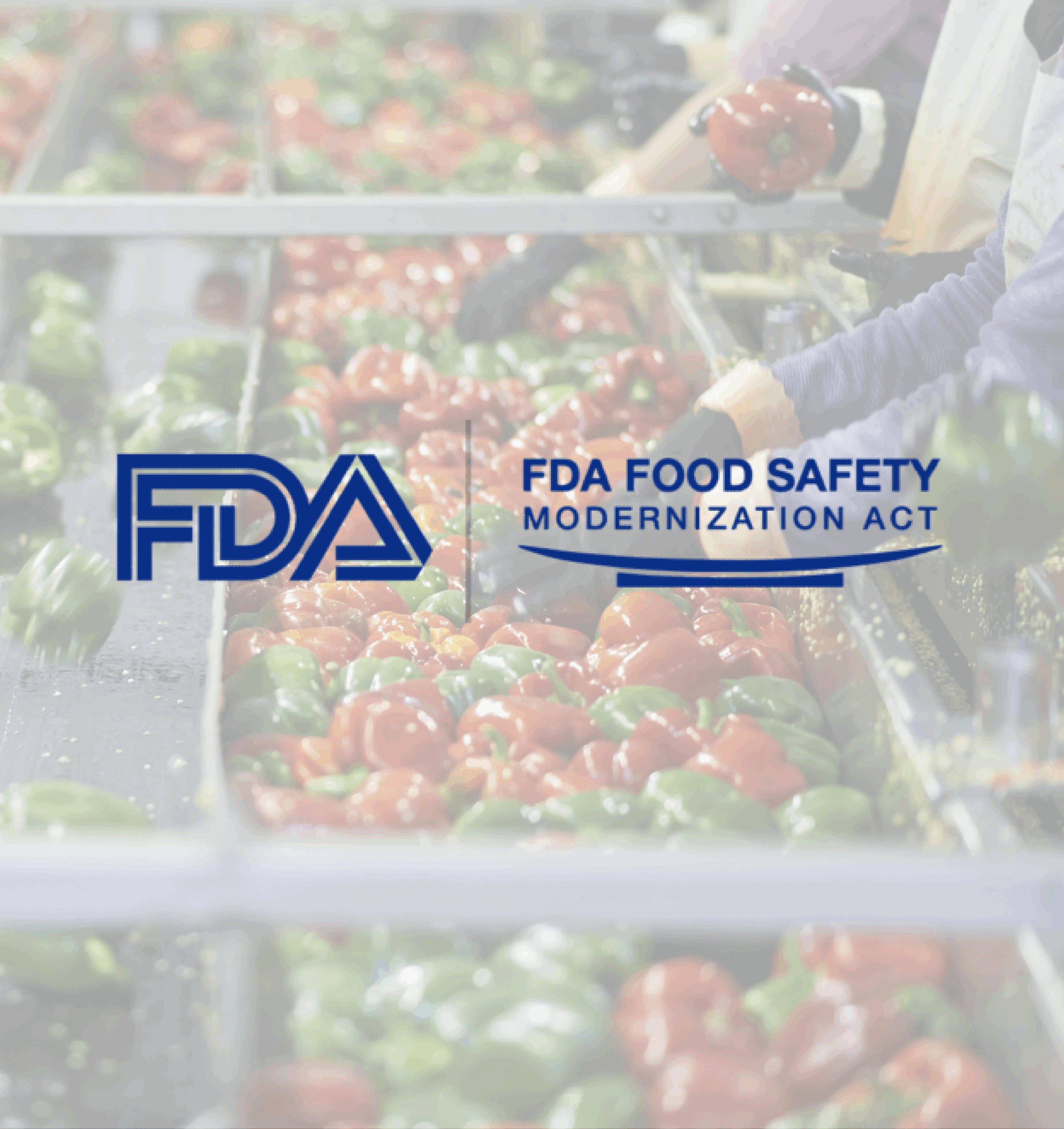It’s no secret that the Food Safety Modernization Act (FSMA) is the most sweeping set of regulations to hit the food industry in the United States, covering a wide range of aspects such as sanitary transportation of human and animal food, food defense, and establishing a robust food safety system. Some of the biggest questions food producers face are what is FSMA compliance, what does it mean, and how do these regulations impact their operations? In this blog post, we delve into these questions and also unpack the 5-step compliance checklist for processors and manufacturers of food products. We will also discuss the new FSMA rule introduced by the FDA and how it enhances food traceability.
What is the Food Safety Modernization Act?
Going by the definition, the Food Safety Modernization Act was signed into law by President Barack Obama on January 4, 2011. The FSMA has given the U.S. Food and Drug Administration new authority to regulate the way foods are grown, harvested, and processed.
In a nutshell, FSMA requires food producers to create a Hazard Analysis Plan documenting everything from sanitization processes to the chemicals used in the glue to attach labels to food packaging. In order to comply with FSMA, documentation is key and making that documentation available within 24 hours of an FDA audit/inspection is critical. It is also critical for food producers to have attained the proper documentation from all their suppliers, no matter where they are in the world – but for most companies gathering this data is far from easy.
What is FSMA Compliance?
The FDA Food safety modernization act comes with a number of compliances. Failing to comply with the norms means that your production facilities can be forced with shutdowns and production stoppages at the request of the FDA. Companies failing to comply face a possibility of thousands and up to millions of dollars in lost revenues.
For packaging, food producers must be able to document themselves or get their suppliers to disclose specifications such as material composition, allergens and additives, physical and chemical properties, and microbiological susceptibility for their packaging and material. These specifications or documentation need to be current and readily available.
The FSMA compliance requirements are a crucial aspect for processors, food manufacturers, and growers in ensuring food safety and meeting the regulations (Produce Safety Rule) set forth by the FDA.
The key focus is on implementing risk-based preventive controls, which involve identifying and addressing potential hazards in the production process of human food and animal feed. Additionally, compliance requires adherence to specific standards such as accredited third-party certification bodies, implementation of mitigation strategies for agricultural water, and compliance with the preventive controls rule. It is essential for food businesses to stay up to date with the evolving FSMA amendments and work in collaboration with regulatory bodies such as the United States Department of Agriculture (USDA) and GOV to ensure accreditation for safe food production for human consumption.
A specific example of how food-packaging specifications must be documented is the coating layer added over printing. It must be documented to ensure that this layer is adequate and suitable for use for food packaging. There could be a potential chemical or odor migration into food. This is of special concern if the ink is touching the product or coming into contact with the surface of packaging, e.g., nested printed rigid plastic cups, rolls of film, stacks of flat cartons, etc.
With the FDA reporting almost half of its recalls due to incorrect or incomplete listing of ingredients and allergen on labels, food labels are a critical area in food safety, and perhaps one of the areas of the FDA’s new regulations where it is easiest to take control. The labeling process will be subject to the same hazard analysis as every other factor of production in the facility and every manufacturer will need a procedure to prevent any possibility of mislabeling – even from ingredients purchased from suppliers around the world.
From requiring and storing certificates from suppliers documenting known allergens to specifying how labels are printed (i.e. forbidding multiple SKUs from being printed on the same sheet at one time), food producers can easily get better control over their labels to avoid costly recalls.
Cloud-Based Specification Data Management for FSMA is a must and with Specright’s Specification Data Management system food producers are given traceability into labels and packaging; It provides a documentation solution that is available 24/7. Some areas within documentation that Specright helps to manage are:
- Approval workflows for artwork revisions/obsoleteness
- Traceability into change/approval history for accountability
- Traceability into supplier communication
- Audit suppliers for compliance with label and packaging specs
What is FSMA Rule 204?
Since the law’s initial passing back in 2011, the sections that make up the legislation have unfolded more and more in complexity.
On November 21, 2022, the Food and Drug Administration (FDA) passed the final rule for the overall FSMA requirements, labeled section 204. The requirement asks affected companies for additional traceability records for certain foods with updated record keeping standards. The overarching goal is to encourage faster identification and removal of foods with potential contamination from the market.
With a more efficient process in place the goal is to reduce preventable food-borne illnesses and/or deaths – positively protecting both consumers and companies.
Key Elements of FSMA 204
It is important to note that section 204 of the Food Safety Modernization Act does not apply to all foods – but specifically targets foods on the food traceability list.
From cheese and leafy greens to nut butters and tropical tree fruits the list is far reaching. Regardless of if a company is selling the food in bulk or as an ingredient in another product, the section requires them to be tracked.
Companies who manufacture, process, pack or hold any of the foods on this list will need to keep Key Data Elements (KDEs) related to specific Critical Tracking Events (CTEs). As stated in FSMA 204 the CTE’s are considered to be harvesting, cooling, initial packaging of raw agricultural or foods, and first land-based receiving of food. For each of these events companies are required to track all key data related and be able to report on it to the FDA.
Goals of FSMA 204
For many companies this is a huge wakeup call, exposing their lack of tribal knowledge and access to data about the products they are producing – one of the main goals coming from the additional section.
In order to reset the standard for traceability compliance the addition of section 204 forces companies to reconsider how they are managing their data. Record keeping will not only empower companies to locate pain points in their supply chains but also reduce recalls and improve food safety for all.
5-Step FSMA Compliance Checklist
As described above, the Food Safety Modernization Act (FSMA) is a set of food safety laws introduced by the United States Food and Drug Administration (FDA) to ensure the safety of the U.S. food supply.
The FSMA places a significant emphasis on preventing food-borne illnesses and reducing the risk of intentional adulteration. If you’re an importer or a small business involved in the importation of food products, it is crucial to comply with FSMA regulations to adhere to food safety standards and protect public health. The following checklist is a great place to start when it comes to getting started with FSMA compliance:
1. Understand the Foreign Supplier Verification Program (FSVP)
The FSVP is a key provision of the FSMA that places responsibility on importers to verify that their foreign food facilities meet US safety standards. Teams that can familiarize themselves with the requirements of the FSVP, which include conducting supplier verification activities, establishing a written program, and ensuring adequate documentation of verification activities, will find this process seamless.
2. Determine applicable compliance dates
Compliance dates vary based on the size of your business and the specific requirements of the FSMA regulations. Analyze where your company stands in the world of FSMA regulations and stay up to date with compliance timelines and implementation dates to avoid fines and other consequences.
3. Implement preventive controls for human food products
Develop and implement a food safety plan that includes preventive controls to minimize or prevent hazards in your food products. This may mean conducting a hazard analysis, identifying preventive controls, establishing monitoring procedures, and documenting your plan’s effectiveness. These preventative controls should be science-based and tailored to the specific hazards associated with your food products.
4. Establish supplier verification procedures
Food suppliers play a key rule when it comes to food safety which is why creating a robust system for verifying the safety of your foreign suppliers is so important. Develop procedures for evaluating and approving suppliers and always conduct audits, and monitor their compliance with applicable food safety regulations over time. And don’t forget to keep thorough documentation of these activities to demonstrate compliance during inspections or audits.
5. Maintain comprehensive records
Accurate and accessible records are essential for demonstrating FSMA compliance. This means organized records and data on your hazard analysis, preventive controls, monitoring activities, supplier approvals, and any corrective actions taken – all retained by the required time period as specified by the FSMA regulations.
By following this 5-step checklist, businesses can strengthen their company’s FSMA compliance and contribute to the overall safety of the US local food supply. It is important to continuously review and update your procedures to align with any changes in FSMA regulations. By prioritizing food safety, especially for imported foods, you not only protect consumers but also build trusted stakeholder relationships, demonstrating your commitment to delivering safe and high-quality food products.
How Does FSMA Affect Food Packaging?
The Food Safety Modernization Act (FSMA) has a significant impact on food packaging within the supply chain program. FSMA’s regulations extend beyond the direct production of food – additionally covering preventive controls for animal food and current good manufacturing practices (CGMP) applicable to food packaging manufacturers.
FSMA emphasizes the implementation of preventative measures to ensure food safety throughout the supply chain program, including packaging materials. Food packaging manufacturers must adhere to CGMP guidelines such as maintaining clean and sanitary facilities, preventing contamination, and employing proper labeling practices.
By complying with FSMA, food packaging plays a crucial role in safeguarding the integrity and safety of food products throughout their journey from production to consumption.
Food Traceability Increases as FDA Releases New FSMA Rule
As the FDA further refined the Food Safety Blueprint in 2020, more detailed rules and regulations have emerged. At the end of September 2020, the FDA proposed a new rule that increases the traceability of “high-risk” foods, i.e., foods that easily spoil or have allergens. The new rule is both a part of the New Era of Smarter Food Safety and completes section 204 of the Food Safety and Modernization Act (FSMA). The FDA’s goal is to phase out the paper trails and inefficiencies surrounding food traceability, starting with foods that pose the greatest risks. The ‘High-Risk’ Foods Include:
- Fresh herbs
- Leafy greens
- Sprouts
- Fish
- Eggs
- Nut butters & more
With this rule, the FDA is setting an expectation that companies are able to pull up detailed traceability information about any given product. Information specifically cited includes lot codes, product descriptions, date of shipment, and date the product was received. But for most companies, this data lives in silos. If the FDA walked through the door today, they wouldn’t be able to access the data they need to prove compliance. This is where specification management offers the perfect solution for better food quality and safety.
By managing products at the specification level, you can tie all related data from the supply chain to a single product, increasing visibility and accessibility. Link any quality and regulatory actions to a finished good, creating an all-inclusive digital product roadmap that puts the right data in the right hands. Specification Management software is built for change, so no matter what new standards or regulations emerge, you can easily configure it to meet your needs.
3 Things to Know About the FDA’s New Food Safety Blueprint for Traceability and Recall Prevention
According to the U.S. Centers for Disease Control and Prevention (CDC), although supply chain technology has helped regulate business activities, food-borne illnesses still wreak havoc on millions of consumers every year. Dubbed the “New Era of Smarter Food Safety,” the purpose of the blueprint is to enhance traceability, increase outbreak response time, and reduce food safety problems. It’s a guide to the future of food safety and a contract between the government, the industry, and public health advocates to bring consumers the highest quality products.
Here’s what you need to know:
1. The Four Core Elements of the Blueprint
The Food Safety Blueprint has four main pillars it’s based upon:
- Tech-enabled Traceability
- Smarter Tools and Approaches for Prevention and Outbreak Response
- New Business Models and Retail Food Modernization
- Food Safety Culture
The first and second elements, Tech-enabled Traceability and Smarter Tools and Approaches for Prevention and Outbreak Response are the vehicles when it comes to modernizing food safety. These core ideas provide the method of change, highlighting the importance of a data-driven approach to quality.
The third core element, New Business Models and Retail Food Modernization is the gas powering the vehicle down the road to better food safety.
COVID-19 has shown us where the industry needs restructuring. In the midst of a pandemic, strict tracking and traceability are crucial, and we’ve certainly hit some potholes along the way. It’s time to rethink how our business models are forcing food safety to take a back seat and create robust new models that prioritize food safety long into the future.
The final core element, Food Safety Culture, is the oil needed to maintain the technology we’re implementing. Without a proper culture shift, change does not stick.
In 2012, the Food Marketing Institute and the Grocery Manufacturers Association found that “the average cost of a recall to a food company is $10M on average, in addition to brand damage and lost sales,” and that number has only increased with the sheer volume of food distributed today. Employees must believe in the value and importance of food safety to mitigate these impacts now and in the future. It’s necessary to receive buy-in and understanding from your staff, leaders, and supply chain vendors and partners so that it becomes a part of your company’s identity.
2. Implementation Expectations
The FDA has assigned leaders to track each core element, utilizing their Food Safety Dashboard to trial what tech-enabled traceability really looks like.
But what does this mean for your company?
It means it’s time to take action.
Supply chain traceability is no longer a luxury but a necessity. Administer and refine your traceability technologies and processes before requirements kick in, and you’re forced to reinvent how you run your supply chain to meet governmental standards.
Utilize the four core elements outlined above to shape how you change your food safety approach. Stay ahead of the curve and jumpstart your traceability efforts today.
3. How Specification Management Can Jumpstart FDA-Approved Traceability Efforts
Luckily, Specification Management has been identified as a supply chain software that can enable end-to-end supply chain visibility and traceability.
Specification Management enables food establishments to better track and digitize the supply chain, helping to reduce issues like product recalls and foodborne diseases.
As we move into an era that prioritizes knowledge and data-driven decisions, it’s time to take the first step and begin digitizing your supply chain.
Are You Ready for the New Era of Smarter Food Safety?
From requiring and storing certificates from suppliers documenting known allergens to specifying how labels are printed (i.e., forbidding multiple SKUs from being printed on the same sheet at one time), food producers can easily get better control over their labels to avoid costly recalls.
If your company is using outdated technology like PDF files, spreadsheets or inflexible ERP solutions to manage your packaging/label specs, now more than ever is the time to make a change. Making the process easier, Specright’s cloud-based solution for specification data management can help food producers manage the documentation of specifications related to their food packaging and labels.
With Specright’s Specification Data Management system, food producers are given traceability into labels and packaging. It provides a documentation solution that is available 24/7. Some areas within the documentation that Specright helps to manage are:
- Approval workflows for artwork revisions/obsoleteness
- Traceability into change/approval history for accountability
- Traceability into supplier communication
- Audit suppliers for compliance with label and packaging specs
Our customers use Specright to share accurate, approved specs with suppliers in real-time, reducing their risks for recalls due to improper packaging/labels. Plus, our packaging Engineering Services team can perform audits of your packaging on a regular basis.
To learn more about how Specright has helped organizations across the food industry, download our ebook on why Specification Data Management is the Future of Food.
Explore More Blogs
Get Started
With Specright’s Solution Suite, you can digitize, centralize, and link your specification data to drive efficiencies, intelligence, traceability, and collaboration within your organization and across your supply chain network.




